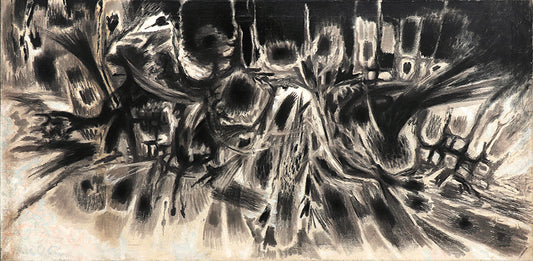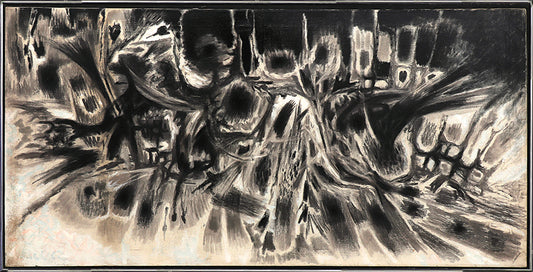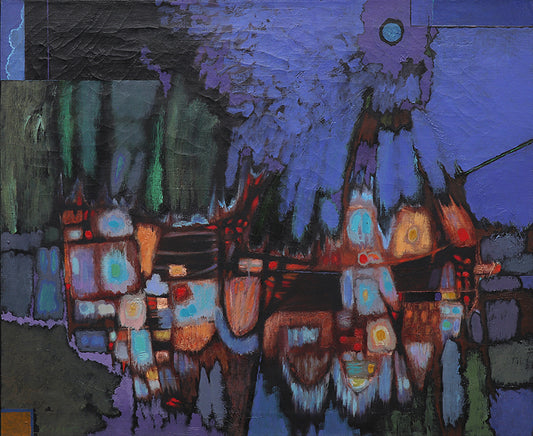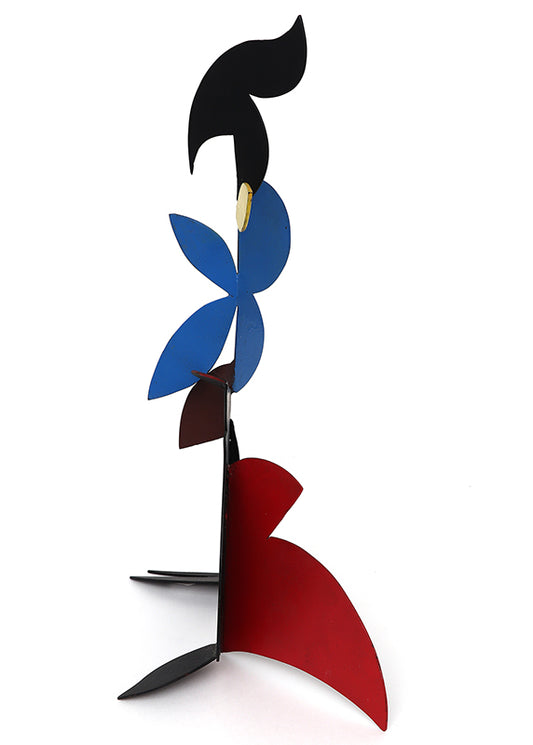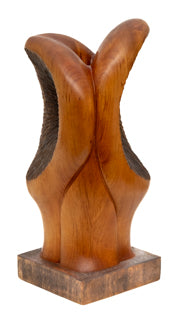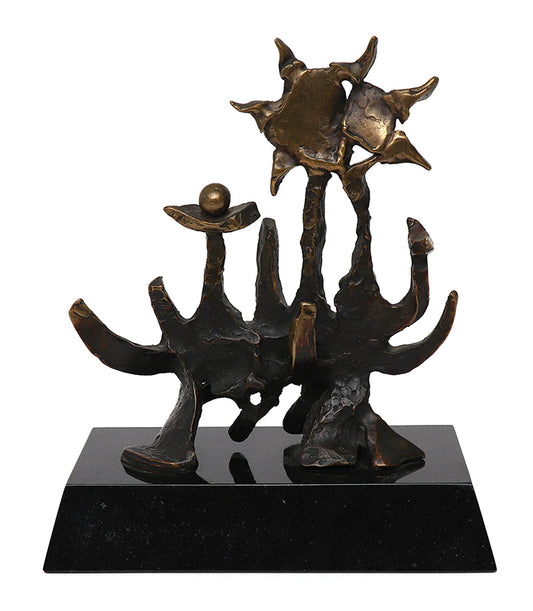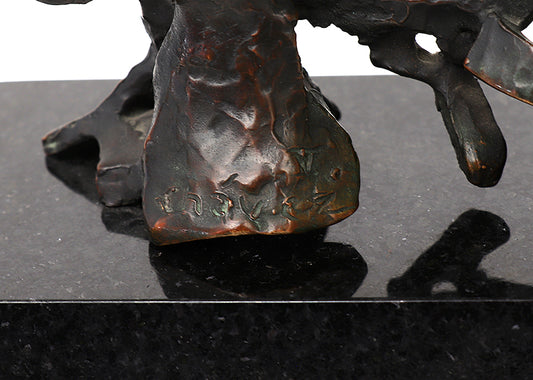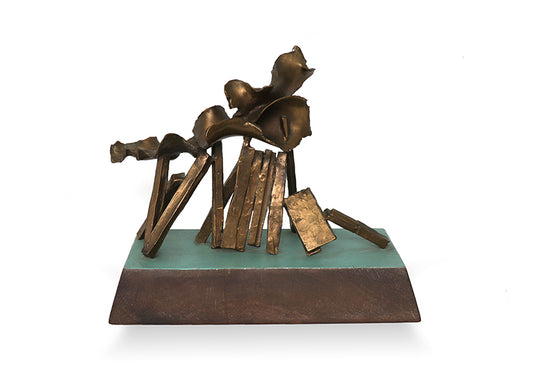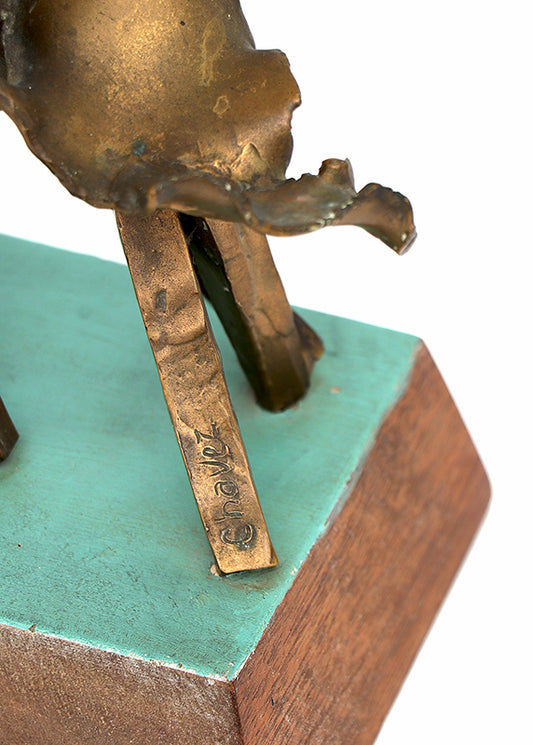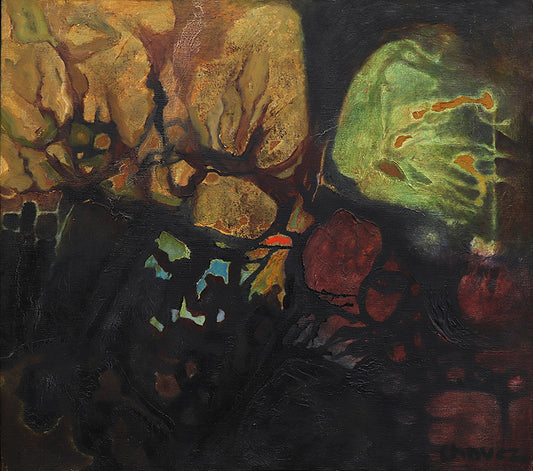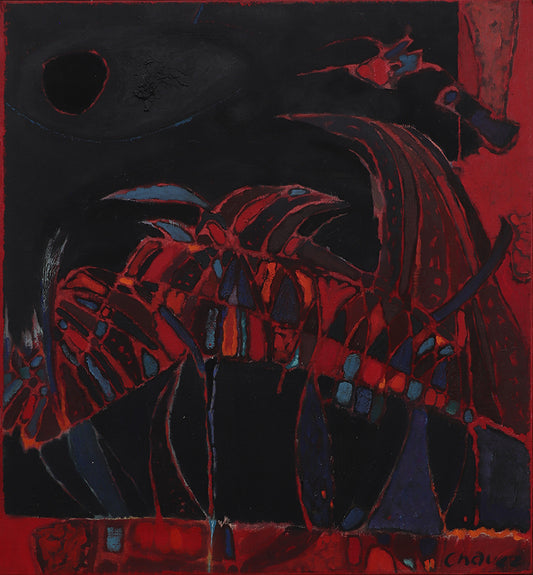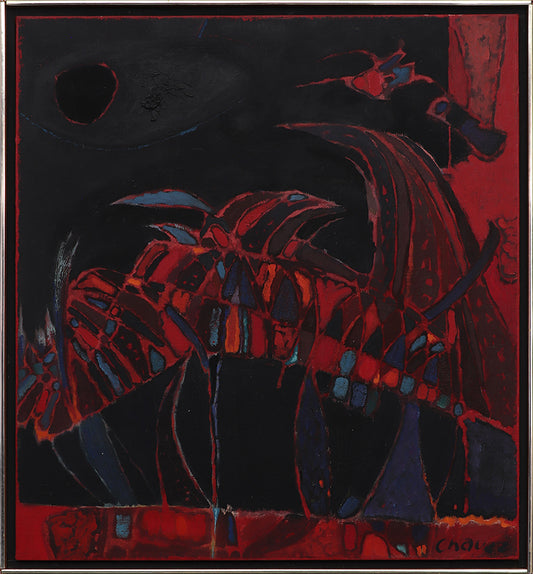Collection: Edward (Eduardo) Chavez (1917-1995)
Studied at the Broadmoor Academy (Colorado Springs Fine Arts Center later settling in Woodstock, NY
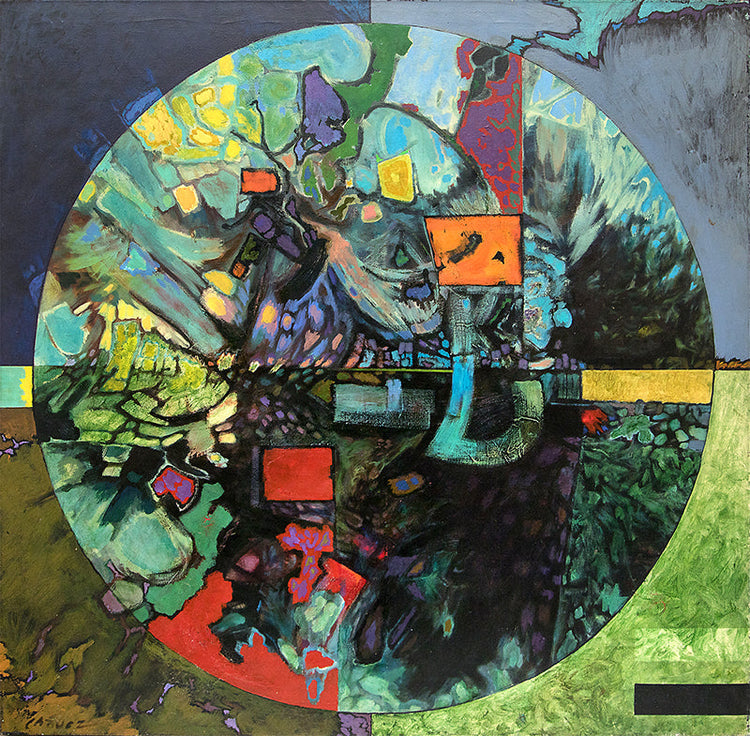
-
Untitled (Black and White Abstract), Painting, circa 1975
Vendor:Edward (Eduardo) Chavez (1917-1995)Regular price $8,750.00Regular priceUnit price / per -
Florentine Night (Abstract in Indigo, Violet, Black, and Green), Painting, circa 1951
Vendor:Edward (Eduardo) Chavez (1917-1995)Regular price $6,750.00Regular priceUnit price / per -
Untitled (Abstract Metal Sculpture), Sculpture
Vendor:Edward (Eduardo) Chavez (1917-1995)Regular price $5,650.00Regular priceUnit price / per -
Untitled (Biomorphic Carved Wood Sculpture), Sculpture, circa 1950-1970
Vendor:Edward (Eduardo) Chavez (1917-1995)Regular price $4,600.00Regular priceUnit price / per -
Untitled (Burning Bush), Sculpture
Vendor:Edward (Eduardo) Chavez (1917-1995)Regular price $4,250.00Regular priceUnit price / per -
Chama (Abstract Sculpture), Sculpture, circa 1966
Vendor:Edward (Eduardo) Chavez (1917-1995)Regular price $4,250.00Regular priceUnit price / per -
Primordial Landscape (Composition in Black, Brown, Ochre, and Green), Painting
Vendor:Edward (Eduardo) Chavez (1917-1995)Regular price $3,250.00Regular priceUnit price / per -
Untitled (Bird Motif), Painting, circa 1980
Vendor:Edward (Eduardo) Chavez (1917-1995)Regular price $3,250.00Regular priceUnit price / per

About the Artist
"My work, my art is to me a means of giving some semblance of dignity and even sanity and meaning to a world too often obsessed with material concerns, with false values and meaningless goals." - Edward Chavez
Muralist, genre and landscape painter, illustrator, sculptor, lithographer and jeweler, Edward Chavez was descended from the early-day Spanish settlers in the present-day American Southwest. He was born into a sheep ranching family of twelve in Ocaté near Wagonmound in northeastern New Mexico. When he was five years old an unusually hard winter wiped out all of the family's livestock and assets, necessitating relocation to Red Lion in northeastern Colorado, where the family earned a meager livelihood working in the local sugar beet fields. Chavez later recalled: "From childhood I knew only poverty and deprivation, and hard struggle and laboring to eke out a subsistence by one's own hands out of a rebelling earth and certainly a resisting society."
His parents encouraged him and his siblings to exceed their own immediate limitation through learning, discovery and adventure. He attended Junior High School in Sterling, Colorado, where his teachers supported his initial desire to become an artist. When his family moved to Denver in 1932, he completed his secondary education at East High School. He credited his art teacher, Helen Perry, for her key role in advancing his career as an artist, as she also did for two other students, Jenne and Ethel Magafan, later his wife and sister-in-law, respectively. They all benefitted from her guidance and art instruction, enhanced by her attendance at the Art Institute of Chicago School and study in Paris with French Cubist painter and sculptor, André Lhote
She also introduced Chavez and the Magafans to artist Frank Mechau of Glenwood Springs, Colorado, who acquainted them with the contemporary French and American painting he had encountered during his earlier three-year sojourn in Paris. When Chavez graduated East High School in 1935, he became apprenticed to Frank Mechau who that year had become affiliated with the Broadmoor Art Academy (succeeded a year later by the Colorado Springs Fine Arts Center). In addition to assisting him with his Federal mural projects in the 1930s, as did the Magafans, Chavez studied with Boardman Robinson, director of the Fine Arts Center and himself a recognized muralist, as well as with faculty members Arnold Blanch and Peppino Mangravite,
As a native of New Mexico, Chavez - like the Magafans - embraced Mechau's artistic approach of universalizing a specific locale in his work. Mechau likewise shared with them the compositional qualities and palette of early Renaissance artists, Paolo Uccello and Piero della Francesca. They informed Chavez's murals painted under the U.S. Treasury Department's Section of Painting and Sculpture for post offices in Geneva, Nebraska (Building a Sod House, 1941) and Center, Texas (Logging Scene, 1941). In 1937 he and Jenne Magafan collaborated on a decorative map for the Glenwood Springs post office. In the late 1930s, under one of the Federal art programs Chavez painted two murals of Western life at West High School in Denver where they can still be seen. As a participant in the Depression-era Federal Art Projects he created several lithographs including El Izquierdo (1939).
Following the attack on Pearl Harbor, Hawaii, in December 1941, he was inducted into the U.S. Army and initially stationed at Fort Warren, Wyoming. For its Service Club he executed Indian of the Plains (1942), a large egg tempera mural on plywood measuring 20 by 45 feet, as well as several other murals at U.S. Army locations in the United States and overseas in Recife, Brazil. He later served as a military art correspondent recording war activities for the U.S. government archives. In 1942 he won third prize in the Life Magazine art competition for men in the armed services. For Christmas that year he was one of ten artist-servicemen who made holiday cards published by the American Artists Group.
Following his military discharge after World War II, Chavez relocated to the art community Woodstock, New York, joining his wife, Jenne Magafan, who had recently moved there from California with her twin sister. Woodstock attracted a number of artists whom he and the Magafans previously had known in Colorado Springs, including Arnold Blanch, Doris Lee and Yasuo Kuniyoshi. In 1947 Chavez received several awards for his work, indicative of the recognition accorded him soon after settling in the East: Pepsi-Cola's Fourth annual Exhibition- "Paintings of the Year," Associated American Artists Lithograph Competition, and the Albany Print Club.
In 1948 Abbott Laboratories commissioned him to do a series of paintings on the state of American Indian health and medicine for the company's publication, What's New. To gather material, he traveled to three reservations: the Chippewas of Red Lake in Minnesota, the Sioux Cheyenne in South Dakota, and the Shoshones and Arapahoes in Wind River, Wyoming. His paintings were later exhibited at the Smithsonian Institution in Washington, DC
In 1948 art professionals nominated him for a Louis Comfort Tiffany Foundation Award, allowing him to visit Mexico. It deepened his connection with Spanish/Mexican culture, enabling him to see firsthand the work of the Mexican Mural School artists Diego Rivera, José Clemente Orozco and David Alfaro Siqueiros that later influenced his own work. The trip also resulted in a stronger, brighter palette reflected in his modernist Desert Still Life (1948) dominated by a deer skull highlighted against large desert rocks. The painting also documents the gradual postwar evolution of his work to a more abstract style.
In 1951 he won a Fulbright Grant allowing him and his wife to paint in Italy for the year. Shortly after their return, he lost her to an unexpected cerebral hemorrhage. His contact with contemporary European art in Italy further reinforced his referentially abstract style as noted by New York Times art critic, Howard Devree, in the review of his one-man show at the Ganso Gallery in New York in 1953. In the context of the rapid post-World War II development of abstract art, Chavez produced Geometric Abstract (1952), a small multi-media drawing of various interlocking geometric shapes highlighted on a grid-like structure with red, black and gray.
In connection with his increasingly abstract work in the 1970s and 1980s, he noted, "I must always begin with very definite subject matter, something I have seen or felt or experienced. [My painting], although abstract in style, is also based on my personal experiences with nature, not with people specifically, but with nature, including people, then it's transferred into abstract terms for me." He also described the transferal process: "If I begin with an idea or a subject matter, it is only the point of take-off from which to venture into an unknown. From then on it is a process of discovery in terms of the chosen medium or material. If in the process the original image is lost - so be it. I must allow it to grow and change and develop in whatever way it must." Often he preceded his painting with a "succession of drawings in black and white, brief statements of my theme, expressing only the essentials in masses of light and dark."
Although he spent the last fifty years of his professional career based in Woodstock, New York, he primarily drew upon the imagery of his native New Mexico and the Rocky Mountain West where he had spent the first half of his life. In the summers he traveled to New Mexico, Utah and Colorado absorbing and sketching the landscape. It became the subject of his strong, bright abstract paintings with titles such as Mojave (Mojave Desert), Green River (Utah), Arroyo Hondo (near Taos, New Mexico), Chaco (Chaco Culture National Historical Park, New Mexico), Enchanted Mesa (near Acoma Pueblo, New Mexico), Ocaté (Chavez's birthplace), and Gunnison (Black Canyon of the Gunnison, Colorado).
Along with his postwar easel painting, Chavez created a number of referentially abstract and totally abstract sculptures in bronze, steel and wood. One of his earliest pieces in this genre was a life-size bronze crucifix he fashioned in 1950 for the Episcopal Chapel in Woodstock. In the 1960s he created several abstract sculptures in black walnut, followed by largely abstract bronzes during the following two decades. Some relate to ancient mythology, such as Icarus, while others are linked to specific geographical locations, such as Chama and Ocaté.
Several bronzes explore Native American subjects, including Ouray (1977, edition of 50). Referencing the nineteenth-century Ute Indian Chief Ouray who lived in southwest Colorado, it is a small standing piece with a slightly protruding shape in the center possibly alluding to an animal-skin Indian shield. In 1977 Chavez sculpted a large standing totem, likewise titled Ouray, in black walnut. He treated the nineteenth-century mining town of Telluride, Colorado, in a small bronze sculpture, Telluride III (c. 1980). He was inspired by the still-visible vestiges of the timber mining structures that began decaying in the mountains around the town following the 1893 Silver Crash and World War I.
Chavez also was known as a fine craftsman for his unusual jewelry exhibited in the 1950s at the Woodstock Guild of Craftsman. He also taught a class in jewelry making at the Guild as well as courses on the Approach to Design through Materials in the 1960s.
He likewise served as an instructor of drawing and painting at the Art Students League in New York (1954) and at its summer school in Woodstock, New York (1955-58). He also was visiting professor of art at Colorado College in Colorado Springs (1959), assistant professor of art at Syracuse University in New York (1960-1961) and instructor in art at Dutchess Community College in Poughkeepsie, New York (1963), and at the Albany Institute of Art in Albany, New York. He was Artist in Residence at the Huntington Museum of Art in West Virginia and lectured at Vassar College.
He was an honorary member of the National Society of Mural Painters, and served as chairman of the Woodstock Artists Association and a member of its Board of Trustees. A recipient of the Childe Hassam Purchase Award from the American Academy of Arts and Letters (1953), he also won the Albany Institute of Art Sculpture award (1965), and the Felton Sculpture award from the Silvermine Guild of Artists (1977). In recognition of his professional accomplishments, Chavez was made an Associate of the National Academy of Design in New York in 1970 and an Academician two years later.
Solo Exhibitions: Chappell House-Denver Art Museum (1938, with Jenne and Ethel Magafan); Associated American Artists, New York (1948-49); Associated American Artists Gallery, New York (1950); Ganso Gallery, New York (1950, 1952-55); New Mexico Museum of Art, Santa Fe (1954); Alexandre Rabow Gallery, San Francisco, California (1954); John Heller Gallery, New York (1955, 1956, 1958, 1959, 1960); Annie Weber Galleries, Detroit, Michigan (1957); New York State Teachers College, Albany (1960); Hawthorn Gallery, Woodstock, New York (1988, with his niece, Jenne Currie, Ethel Magafan's daughter).
Group Exhibitions: World's Fair, New York (1939-40); Art Institute of Chicago (1939-40, 1942-43,1946); deYoung Museum, San Francisco, California (1939); "New Acquisitions: American Paintings and Sculpture," Museum of Modern Art, New York (1940); "51st Annual Exhibition of American Paintings," Art Institute of Chicago (1940); San Francisco Museum of Modern Art, California (1940, 1941, 1944, 1945); "Art in War: OEM Purchases from a National Exhibition," Museum of Modern Art, New York (1942); Pennsylvania Academy of the Fine Arts, Philadelphia (1942-1960); "13th Annual Statewide Art Exhibition of Paintings," Santa Cruz, California (1942); National Academy of Design, New York (1943); Los Angeles Museum of Art, California (1944, 1945); "1st Annual Summer Show," Woodstock Artists Association, New York (1946); "Biennials," Corcoran Gallery of Art, Washington, DC (1949,1957); "Painting Annual," Whitney Museum of American Art, New York (1951); "American Indian Affairs," American Museum of Natural History, New York (1951); "Expressionism in American Painting," Albright-Knox Gallery, Buffalo, New York (1952); Galleria Del Camino, Rome, Italy (1952); "Fifth Annual Exhibition of Contemporary American Painting," University of Illinois at Urbana (1952); "Rio Grande Painting," New Mexico Museum of Art, Santa Fe (1955); "Fulbright Painters," Colorado Springs Fine Arts Center (1961); "1th Annual Drawing and Small Sculpture Show," Ball State University Art Gallery, Muncie, Indiana (1965); "Regional Exhibition by Artists of the Upper Hudson," Albany Institute of History and Art, Albany, New York (1966); "A Show of Color," Colorado Springs Fine Arts Center (1971); "Woodstock Artists and the Federal Art Projects of the WPA Era," Historical Society of Woodstock, New York (1985); "50 Years of the Mohawk-Regional, 1936-1986," State University of New York at Albany (1986); Bronx Museum of Art, New York (1988); Colorado Springs Fine Arts Center (1989); "Sin Nombre: The Hispana/o Artists of the New Deal Era," Museum of International Folk Art, Santa Fe, New Mexico (1999-2000).
Collections: Metropolitan Museum of Art, Museum of Modern Art, and Whitney Museum of American Art - all in New York; Historical Society of Woodstock, New York; Woodstock Artists Association, New York; Newark Museum, New Jersey; Smithsonian American Art Museum, Washington, DC, Library of Congress Print Collection, and American University - all Washington, DC; Pennsylvania Academy of the Fine Arts, Philadelphia; Detroit Museum of Art; Butler Institute of American Art, Youngstown, Ohio; University of Michigan Museum of Art, Ann Arbor; Art Institute of Chicago; Sheldon Memorial Art Gallery, Lincoln, Nebraska; San Diego Museum of Art, California; Roswell Museum and Arts Center, New Mexico; Denver Public Library, Western Art Collection; Kirkland Museum of Fine & Decorative Art, Denver, Colorado.
©Stan Cuba for David Cook Galleries, LLC
